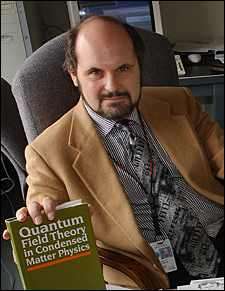Observation of Confinement Phenomenon in Condensed Matter
Force of interaction between magnetic particles grows stronger with increasing distance
November 29, 2009
UPTON, NY — An experiment has confirmed that spinons, particle-like magnetic excitations, can be confined in a magnetic insulator similar to the way elementary quarks are confined within individual protons and neutrons. The finding, in a well-described magnetic system, may offer new ways to explore Quantum Chromodynamics, the theory that describes the fundamental interactions of quarks.
The observations of spinon confinement were made at the Science and Technology Facilities Council’s Rutherford Appleton Laboratory in the United Kingdom by an international team of physicists. The team realized serendipitously that a theory developed 12 years earlier by theoretical physicist Alexei Tsevelik, now at the U.S. Department of Energy’s Brookhaven National Laboratory, and collaborators accurately predicted the current findings. Together, the scientists describe the theory and their new observations in the November 29th issue of Nature Physics.
“The concept of confinement is one of the central ideas in modern physics, being at the core of the theory of nuclear forces,” Tsvelik said. “In certain systems, when constituent particles are bound together by an interaction whose strength increases with increasing particle separation, individual particles cannot exist in a free state and therefore can be observed only indirectly.”
The most famous example of confinement is of quarks which are held together in protons and neutrons, for example, by the strong force, a force that grows stronger with increasing distance.
“It has been interesting for us that a similar situation of confinement can be modeled in condensed matter systems,” Tsvelik said. “Instead of quarks being confined in protons and neutrons, we have other quantum entities that act just like particles — elementary excitations of magnetic systems called spinons.”
In the case of the current experiment, the spinons exist on parallel chains of copper-oxide separated by inert calcium. Spinons on individual chains are not confined, but as soon as two chains are brought together to form ladder-like arrangements, the inter-ladder interactions confine the spinons.
“That is, the spinons can appear now only in pairs and cannot fly away from each other too far,” Tsvelik said. “The result of this confinement is a particle we call a ‘magnon.’ It is like two quarks pairing up to form a meson.”
The original theory paper published by Tsvelik and collaborators 12 years ago described the magnetic excitation spectrum of such a system in detail. The team performing the experiments at Rutherford observed a signature that fit that description.
“Now that we have an example of confinement in a condensed matter system, our next step is to check further predictions of the theory to make sure there are no unpleasant surprises,” Tsvelik said. The scientists will also measure the responses in other compounds to see if they observe similar effects.
Tsvelik’s research is funded by the DOE Office of Science.
Upon publication, the paper can be downloaded here.
The Science and Technology Facilities Council ensures the UK retains its leading place on the world stage by delivering world-class science; accessing and hosting international facilities; developing innovative technologies; and increasing the socio-economic impact of its research through effective knowledge exchange partnerships. The Council has a broad science portfolio including Astronomy, Particle Physics, Particle Astrophysics, Nuclear Physics, Space Science, Synchrotron Radiation, Neutron Sources and High Power Lasers. In addition the Council manages and operates three internationally renowned laboratories: The Rutherford Appleton Laboratory, Oxfordshire; The Daresbury Laboratory, Cheshire; and The UK Astronomy Technology Centre, Edinburgh. For more information, visit: http://www.stfc.ac.uk.
2009-11025 | INT/EXT | Newsroom










